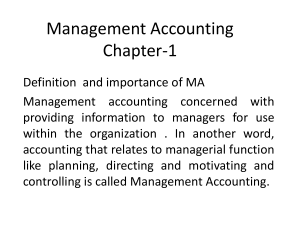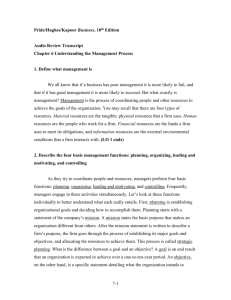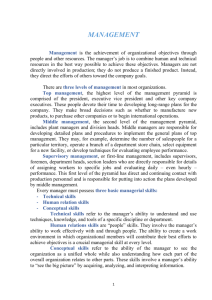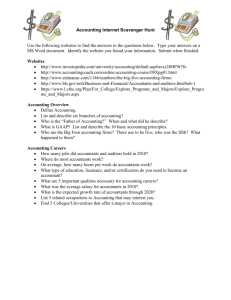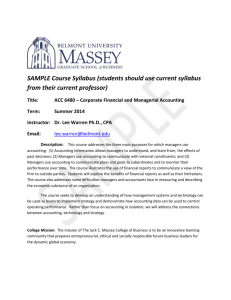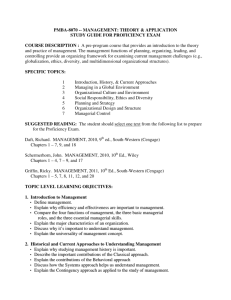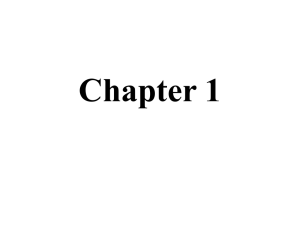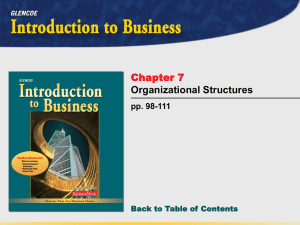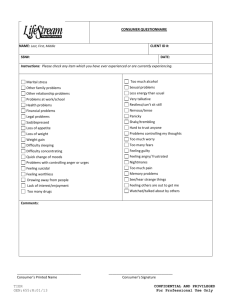Class Lecture 1: Introduction to Management Accounting
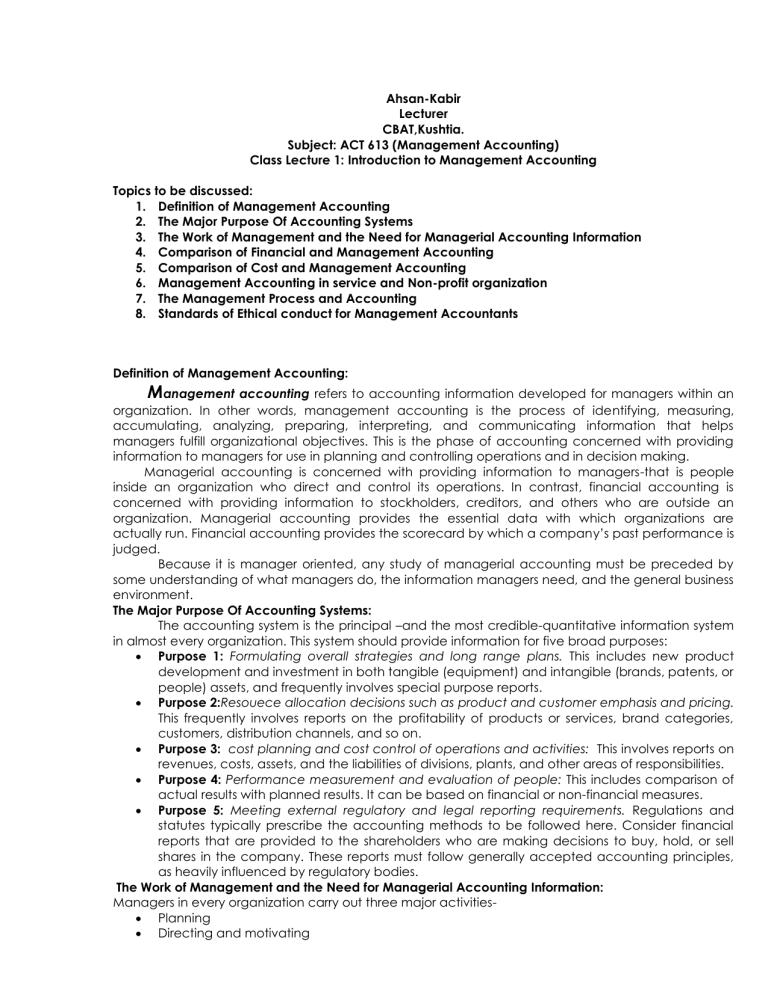
Ahsan-Kabir
Lecturer
CBAT,Kushtia.
Subject: ACT 613 (Management Accounting)
Class Lecture 1: Introduction to Management Accounting
Topics to be discussed:
1.
Definition of Management Accounting
2.
The Major Purpose Of Accounting Systems
3.
The Work of Management and the Need for Managerial Accounting Information
4.
Comparison of Financial and Management Accounting
5.
Comparison of Cost and Management Accounting
6.
Management Accounting in service and Non-profit organization
7.
The Management Process and Accounting
8.
Standards of Ethical conduct for Management Accountants
Definition of Management Accounting:
M
anagement accounting refers to accounting information developed for managers within an organization. In other words, management accounting is the process of identifying, measuring, accumulating, analyzing, preparing, interpreting, and communicating information that helps managers fulfill organizational objectives. This is the phase of accounting concerned with providing information to managers for use in planning and controlling operations and in decision making.
Managerial accounting is concerned with providing information to managers-that is people inside an organization who direct and control its operations. In contrast, financial accounting is concerned with providing information to stockholders, creditors, and others who are outside an organization. Managerial accounting provides the essential data with which organizations are actually run. Financial accounting provides the scorecard by which a company’s past performance is judged.
Because it is manager oriented, any study of managerial accounting must be preceded by some understanding of what managers do, the information managers need, and the general business environment.
The Major Purpose Of Accounting Systems:
The accounting system is the principal –and the most credible-quantitative information system in almost every organization. This system should provide information for five broad purposes:
Purpose 1: Formulating overall strategies and long range plans. This includes new product development and investment in both tangible (equipment) and intangible (brands, patents, or people) assets, and frequently involves special purpose reports.
Purpose 2:Resouece allocation decisions such as product and customer emphasis and pricing.
This frequently involves reports on the profitability of products or services, brand categories, customers, distribution channels, and so on.
Purpose 3: cost planning and cost control of operations and activities: This involves reports on revenues, costs, assets, and the liabilities of divisions, plants, and other areas of responsibilities.
Purpose 4: Performance measurement and evaluation of people: This includes comparison of actual results with planned results. It can be based on financial or non-financial measures.
Purpose 5: Meeting external regulatory and legal reporting requirements. Regulations and statutes typically prescribe the accounting methods to be followed here. Consider financial reports that are provided to the shareholders who are making decisions to buy, hold, or sell shares in the company. These reports must follow generally accepted accounting principles, as heavily influenced by regulatory bodies.
The Work of Management and the Need for Managerial Accounting Information:
Managers in every organization carry out three major activities-
Planning
Directing and motivating
And Controlling
Planning involves selecting a course of action and specifying how the action will be implemented.
Directing and motivating involves mobilizing people to carry out plans and run routine operations.
Controlling involves ensuring that the plan is actually carried out and is appropriately modified as circumstances change. In carrying out the control function, managers seek to ensure that the plan is being followed. Feedback, which signals whether operations are on track, is the key to effective control.
Management accounting information plays a vital role in these basic management activities-but most particularly in the planning and control functions.
The planning and Control Cycle:
The work of management can be summarized in a model such as the following model-
Formulating long and short term plans (Planning)
Comparing actual to planned performance (Controlling)
Decision Making Implementing plans
(Directing and Motivating)
Measuring performance (Controlling)
The model, which depicts the Planning and Controlling Cycle, illustrates the smooth flow of management activities from planning through directing and motivating, controlling, and then back to planning again.
For more details see textbook; Page 4
Comparison of Financial and Management Accounting:
Accounting
Recording
Summarizing
Financial Accounting Managerial Accounting
Reports to those outside the organization:
Owners
Lenders
Tax authorities
Regulators
Emphasis is on summaries of financial consequences of past activities
Objectivity and verifiability of data are emphasized
Precision of information is required
Only summarized data for the entire organization are prepared
Must follow GAAP
Mandatory for external reports
For more details see textbook; Page no 7.
Management Accounting and cost Accounting:
Reports to those inside the organization for:
Planning
Directing and motivating
Controlling
Performance evaluation
Emphasis is on decisions affecting the future
Relevance and flexibility of data are emphasizes
Timeliness of information is required
Detailed segment reports about departments, products, customers, and employees are prepared
Need not follow GAAP
Not mandatory
The accounting service through which management is assisted, at all levels, in respect of policy making, planning, controlling the execution of plans and appraising of performance, is known as Management Accounting. It is a recent development, but is gaining importance rapidly in various concerns. Management accounting utilizes the information of both financial accounting and cost
Management Accounting
accounting in the best interest of the business. It is primarily concerned with supply of information to the management so that the management can manage the business efficiently in order to maximize profit. Management accounting employees many techniques such as budgetary control, marginal analysis, uniform costing, standard costing, ratio accounting, project accounting, internal audit, fund flow analysis etc.
Cost accounting also supplies information to the management and it utilizes most of the above techniques also. So the principal objective of both management accounting and cost accounting is similar. Thus, Cost accounting may be considered as apart of management accounting or management accounting may be considered as the managerial aspect of cost accounting.
Management Accounting in Service and Non-profit organization:
The basic ideas of management accounting were developed in manufacturing organizations.
These ides, however, have evolved so that they apply to all types of organizations including service organizations. Service organizations, for our purposes, are all organizations other than manufacturers, wholesalers, and retailers. That is, they are organizations that did not make or sell tangible goods.
Public accounting firms, law firms, management consultants, real estate firms, transportation companies, bank, insurance companies, and hotels, are profit seeking service organizations.
Almost all nonprofit organizations, such as hospitals, schools, libraries, museums, and government agencies, are also service organizations. Managers and accountants in nonprofit organizations have much in common with their counterparts in profit seeking organizations. There is money to be raised and spent. There are budgets to be prepared and control systems to be designed and implemented. There is an obligation to use resources wisely.
The characteristics of both profit seeking and nonprofit service organizations include the following:
1.Labour is intensive: The highest proportion of expenses in schools and law firms are wages, salaries, and payroll –related costs, not the cost relating to the use of machinery, equipment, and other physical facilities.
2.Output is usually difficult to define: the output of a university may be defined as the number of degrees granted, but many critics would maintain that the real output is “what is contained in the students brains”. Therefore, measuring output is often considered impossible.
3.Major inputs and outputs cannot be stored: an empty airline seat cannot be saved for a later flight, and a hotel’s available labor force and rooms are either used or unused as each day occurs.
Simplicity is the watchword for installation of systems in service industries and non –profit organizations. In fact, many professionals such as physicians, professors, or government officials resist even filling out a time card. In fact, simplicity is a fine watchword for the design of any accounting system. Complicity tends to generate costs of gathering and interpreting data that often exceed prospective benefits.
Cost benefit and behavioral considerations:
In addition to simplicity, managers should keep two other ideas in mind when designing accounting systems:
1.Cost benefit balances
2.behavioral implications
The cost benefit balance weighing estimated costs against probable benefits-is the primary consideration in choosing among accounting systems and methods.
In addition to the costs and benefits `of an accounting system, the buyer of such a system should also consider behavioral implications, that is the system’s effect on the behavior (decisions) of managers. The system must provide accurate, timely budgets and performance reports in a form useful to the managers. If managers do not use accounting reports, the reports create no benefits.
Management accounting reports affect employee’s feelings and behavior. Consider a performance report that is used to evaluate the operations under responsibility of a particular manager. If the report unfairly attributes excessive costs to the operation, the manager may lose confidence in the system and not let it influence future decisions. In contrast, a system that managers trust and believe in can be a major influence on their decisions and actions.
The Management Process and Accounting:
Regardless of the type of organization, manager’s benefit when accounting provides information that helps them plan and control the organization’s operations.
The Nature of Planning and Controlling
The management process is a series of activities in a cycle of planning and control. Decision-
making –the purposeful choice among a set of alternative courses of action designed to achieve some objectives-is the core of the management process. Decisions range from routine (making daily production schedules) to the nonroutine (launching a new product line)
Decisions within an organization are often divided into two types: (1) planning decisions and
(2) control decisions.
In practice, planning and control are so intertwined that it seems artificial to separate them. In studying management, however, it is useful to concentrate on either the planning phase or the control phase to simplify the analysis.
The Management process
Planning
(Deciding)
Internal Accounting System
Budgets, special reports
Source documents, such as, Bills from
Suppliers
Records and
Measurements
Action
(Implementing)
General and Subsidiary ledgers
Classifications of
Actions
Controlling
Evaluation
(Feedback)
Reports of actions,
Comparing budgets
with results
The left side of the above model demonstrates the planning and control cycle of the current operations. Planning refers to setting objectives and outlining how they will be attained. Thus planning provides the answers to two questions: What is desired? When and how it will be accomplished? In contrast, controlling (the two boxes labeled “Action” and “Evaluation”) refers to implementing plans and using feedback to attain objectives. Feedback is crucial to the cycle of planning and control.
Planning determines action; action generates feedback, and feedback influences further planning.
Timely, systematic reports provided by the internal accounting system are the chief source of useful feedback. None of this cycle would be possible without accounting.
Management By Exception:
The right side of the above model shows that accounting formalizes plans by expressing them as budgets. A Budget is a quantitative expression of a pan of action. It is also and aid to coordinating and implementing the plan. Accounting formalizes control as performance reports (the last box), which provide feedback by comparing results with plans and by highlighting variances, which are deviations from plans. The accounting system records, measures, and classifies actions in order to produce performance reports.
Performance reports spur investigation of exceptions-items for which actual amounts differ significantly from budgeted amounts. Operations are then made to conform with the plans, or the plans are revised. This is often called management by exception, which means concentrating on areas that deviate from the plan and ignoring areas that are presumed to be running smoothly. Thus
the management by exception approach frees managers from needles concern with those phases of operations that are adhering to plans.
Standards of Ethical conduct for Management Accountants:
Management accountants have an obligation to the organizations they serve, their profession, the public, and themselves to maintain the highest standards of ethical conduct. In recognition of this obligation the governing body of worldwide accounting has developed adopted the following standards of ethical conduct for management accountants. Adherence to theses standards is integral to achieving the objectives of management accounting. Management accountants shall not commit acts contrary to these standards nor shall t6hey condone the commission of such acts by others within their organization.
Competence
Management accountants have a responsibility to
Maintain an appropriate level of professional competence by ongoing development of their
knowledge and skills
Perform their professional duties in accordance with relevant laws, regulations, and technical standards
Prepare complete and clear reports and recommendations after appropriate analysis of relevant and reliable information
Confidentiality
Management accountants have a responsibility to
Refrain from disclosing confidential information acquired in the course of their work except when authorized, unless legally obligated to do so
Inform subordinates as appropriate regarding the confidentiality of information acquired in the course of their work and monitor their activities to assure the maintenance of that
confidentiality
Refrain from using or appearing to use confidential information acquired in the course of their work for unethical or illegal advantage either personally or through third parties
Integrity
Management accountants have a responsibility to
Avoid actual or apparent conflicts of interest and advise all appropriate parties of any potential conflict
Refrain from engaging in any activity that would prejudice their ability to carry out their duties ethically
Refuse any gift, favor, or hospitability that would influence or would appear to influence their actions
Refrain from either actively or passively subverting the attainment of the organization’s legitimate and ethical objectives
Recognize and communicate professional limitations or other constraints that would preclude responsible judgment or successful performance of an activity
Communicate unfavorable as well as favorable information and professional judgments or opinions
Refrain from engaging in or supporting any activity that would discredit the profession
Objectivity
Management accountants have a responsibility to
Communicate information fairly and objectively
Disclose fully all relevant information that could reasonably be expected to influence an intended user’s understanding of the reports, comments, and recommendations
For more details see textbook; Page no 29,30,31,32
The Changing Business Environment:
The business environment in recent years has been characterized by increasing competition and relentless drive for continuous improvement. Several approaches have been developed to assist organizations in meeting this challenges-including Just in time (JIT), total quality management (TQM), process reengineering, and the theory of constraints (TOC).
JIT emphasis the importance of reducing inventories to the barest minimum possible. This reduces working capital requirements, frees up space, reduces through put time, reduces effects, and eliminates waste.
TQM involves focusing on the customer, and it employs systematic problem solving using teams made up front line workers. Specific TQM tools include bench marking and the plan-do –check act (PDCA) cycle. By emphasizing teamwork, a focus on the customer, and facts, TQM can avoid the organizational infighting that might otherwise block improvement.
Process reengineering involves completely redesigning a business process in order to eliminate non-value added activities and to reduce opportunities for errors. Process reengineering relies more on outside specialists than TQM and more likely to be imposed by top management.
The theory of constraints emphasizes the importance of managing the organizations constraints. Since the constraints are whatever is holding back the organization, improving efforts usually must be focused on the constraint in order to be really effective.
For more details see textbook; Page no from 10 to 24.
Questions:
1.What is management accounting?
2.What are the major activities of a manager?
3.describe the steps in the planning and control cycle.
4.What are the major differences between managerial and financial accounting?
5. What are the major differences between managerial and cost accounting?
6.How does the plant layout differ in a company using JIT as compared to a company that uses a more conventional approach to manufacturing? What benefits accrue from a JIT layout?
7.Why is process reengineering a more radical approach to improvement than total quality management?
8. Why is adherence to ethical standards important for the smooth functioning of an advanced market economy?
Problems: P1-7 (Page no. 38); P1-9 (Page no. 39)
Note: The students are requested to read the textbook very carefully. By reading the textbook along with this material you would be able to clear your concepts. So please read your textbook. If necessary you may consult other reference books.
Good luck
